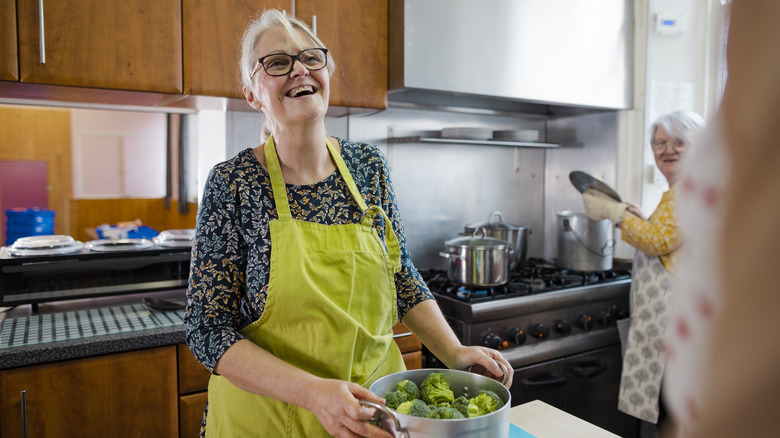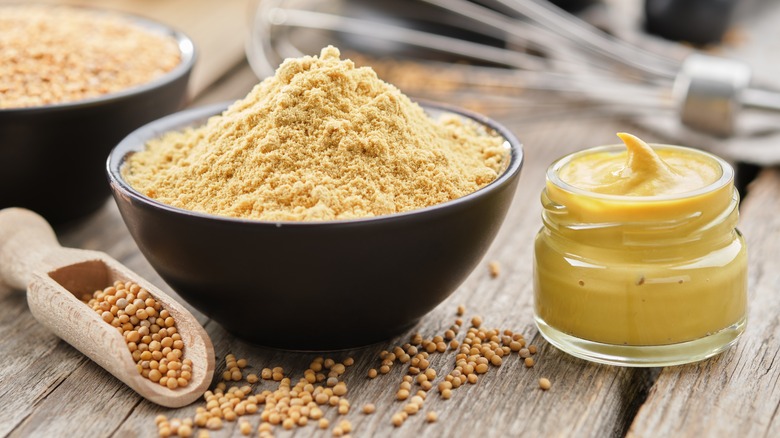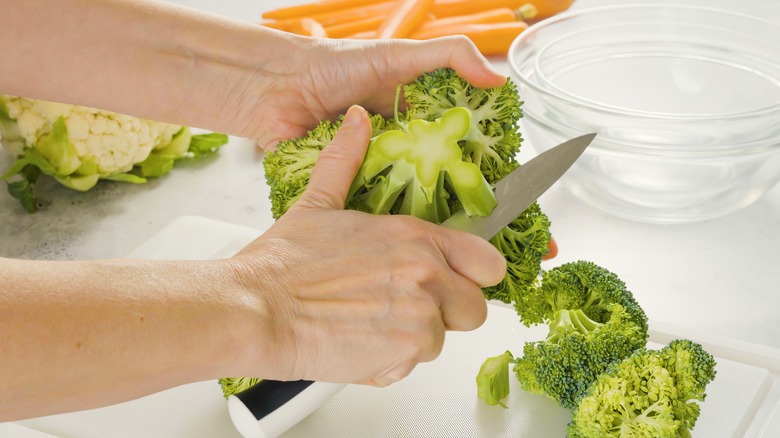An Unexpected Condiment Makes Broccoli So Much Healthier
Broccoli is a top-tier competitor when it comes to nutritional value. With its earthy yet light flavor, broccoli has no shortage of essential vitamins and minerals that our bodies will surely thank us for. According to the U.S. Department of Agriculture (USDA), in a 100-gram serving of raw broccoli, you can find 2.57 grams of protein, 2.4 grams of fiber, 46 milligrams of calcium, over 91 milligrams of vitamin C, and a mighty 303 milligrams of potassium. You'll also get a healthy dose of iron, magnesium, zinc, phosphorus, and much more.
One of broccoli's greatest attributes is that it can be enjoyed in any number of ways. Whether you bake it, sauté it, steam it, or enjoy its crisp, raw crunch, broccoli can serve as a nutritious stand-alone snack or a delicious complement to almost any meal. However, as with many other foods, some of that nutritional value gets lost in the cooking process. Thankfully, if you're a fan of cooked broccoli, know that there's one condiment that can swoop in and save the day.
The power of powdered mustard
Possessing cancer-protective properties, broccoli contains sulforaphane (via NutritionFacts.org). However, the production of sulforaphane is only made possible through the combination of myrosinase and glucosinolate glucoraphanin found within the vegetable. When cooking broccoli, however, we lose myrosinase in the process.
But this doesn't mean we have to limit ourselves solely to raw broccoli in order to reap the vegetable's potential anticarcinogenic effects. Rather, researchers from a 2018 study published in Molecular Nutrition & Food Research found that replenishing lost myrosinase by adding in an outside food source can help restore broccoli's sulforaphane content. What was that outside source, you ask? Powdered mustard seed. In the study, 12 participants were given 200 grams of cooked broccoli. Within 24 hours, the researchers found that the sulforaphane metabolite concentration in participant urine samples more than quadrupled in relation to eating cooked broccoli with 1 gram of powdered brown mustard as opposed to eating just plain cooked broccoli.
What if you're not a fan of powdered mustard?
The study reinforces findings from earlier research, including a 2013 study published in Food Chemistry in which researchers examined the myrosinase degradation process in cooking broccoli. The research revealed that although boiling broccoli greatly hindered the formation of sulforaphane, adding powdered mustard seeds to cooked broccoli boosted sulforaphane production.
However, if mustard is not your condiment of choice, Dr. Michael Greger, founding member and Fellow of the American College of Lifestyle Medicine, writes via NutritionFacts.org that there may be another method one can use to preserve broccoli's sulforaphane content — if you prepare it correctly. Dr. Greger explains that the combined activation of myrosinase and glucosinolate glucoraphanin also occurs in response to cutting up broccoli. If you then let the vegetable sit for a little while, sulforaphane forms. Termed the "hack-and-hold technique," Dr. Greger suggests slicing up raw broccoli in advance and then walking away for 40 minutes. Once the sulforaphane forms, it's not going anywhere. You're in the clear to enjoy all the health benefits your cooked broccoli has to offer.



